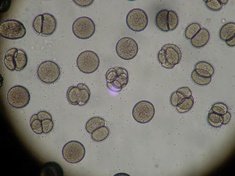Featured Quizzes
User Quizzes
Create Quiz
Data and Charts
Badges and Games
About JetPunk
JetPunk Shop
Dark Mode

Developmental and Stem Cell Biology Quiz
Stem Cells are very interesting cells.
Try to answer these questions correctly
Rate:
Last updated: December 26, 2022
You have not attempted this quiz yet.
More quiz info >>
| First submitted | December 26, 2022 |
| Times taken | 10 |
| Average score | 46.7% | Report this quiz | Report |
7:30
The quiz is paused. You have remaining.
Scoring
You scored / = %
This beats or equals
% of test takers
also scored 100%
The average score is
Your high score is
Your fastest time is
Keep scrolling down for answers and more stats ...
1.
The zygote is
Totipotent
✓
Unipotent
✓
Multipotent
✓
Pluripotent
✓
2.
Pluripotent Stem Cells resemble the cells of the
Hypoblast
✓
Epiblast
✓
Zygote
✓
Trophectoderm
✓
3.
OCT4, SOX2, c-MYC, and KLF4 are also known as
The Yamanaka Factors
✓
The Takashima Factors
✓
The Gurdon Factors
✓
The Smith Factors
✓
4.
These factors are used to make
Induced pluripotent stem cells
✓
Hematopoietic stem cells
✓
Embryonic stem cells
✓
IVF embryos
✓
5.
These factors are
Chromatin Regulators
✓
Cytokines
✓
Transcription factors
✓
Antibodies
✓
6.
Naive Pluripotent Stem Cells resemble the cells of
the pre-implantation epiblast
✓
the cells of the morula
✓
the post-implantation epiblast
✓
the blastocyst
✓
7.
Primed Pluripotent Stem Cells resemble the cells of
the pre-implantation epiblast
✓
the blastocyst
✓
the post-implantation epiblast
✓
the cells of the morula
✓
8.
A blastocyst embryoid (embryo organoid/ 3D-stem cell based embryo-model) is also called
An embryonic spheroid
✓
A Blastoid
✓
An embryoid body
✓
A Humanoid
✓
9.
Pluripotent stem cells can give rise to
All embryonic cell lineages
✓
All extra-embryonic cell lineages
✓
All foetal cell lineages
✓
All cell lineages
✓
10.
The process of developmental maturation/specialization of a cell is called
Trans-differentiation
✓
Cis-differentiation
✓
Reprogramming
✓
Differentiation
✓
11.
The process of developmental rejuvenation is called
Cis-differentiation
✓
Trans-differentiation
✓
Reprogramming
✓
Differentiation
✓
12.
The process of conversion of one cell-type to the other without developmental rejuvenation is called
Cis-differentiation
✓
Reprogramming
✓
Trans-differentiation
✓
Differentiation
✓
13.
XX/female naive pluripotent stem cells are hallmarked by
Random X-chromosome inactivation
✓
Paternal X-chromosome inactivation
✓
Two active X-chromosomes
✓
Maternal X-chromosome inactivation
✓
14.
Conrad Waddington famously compared the cellular developmental process to
Balls falling on pins
✓
A person walking through a forest
✓
Marbles rolling down a hill
✓
A river flowing through a valley
✓
15.
What is a stem cell?
A cell that can proliferate and give rise to other cells
✓
A cell that can self-renew and give rise to other cells
✓
A cell that can divide
✓
A cell that can give rise to other cells
✓
Comments
No comments yet
New and Popular
Save Your Progress
Copyright H Brothers Inc, 2008–2024
Contact Us | Go To Top | View Mobile Site
